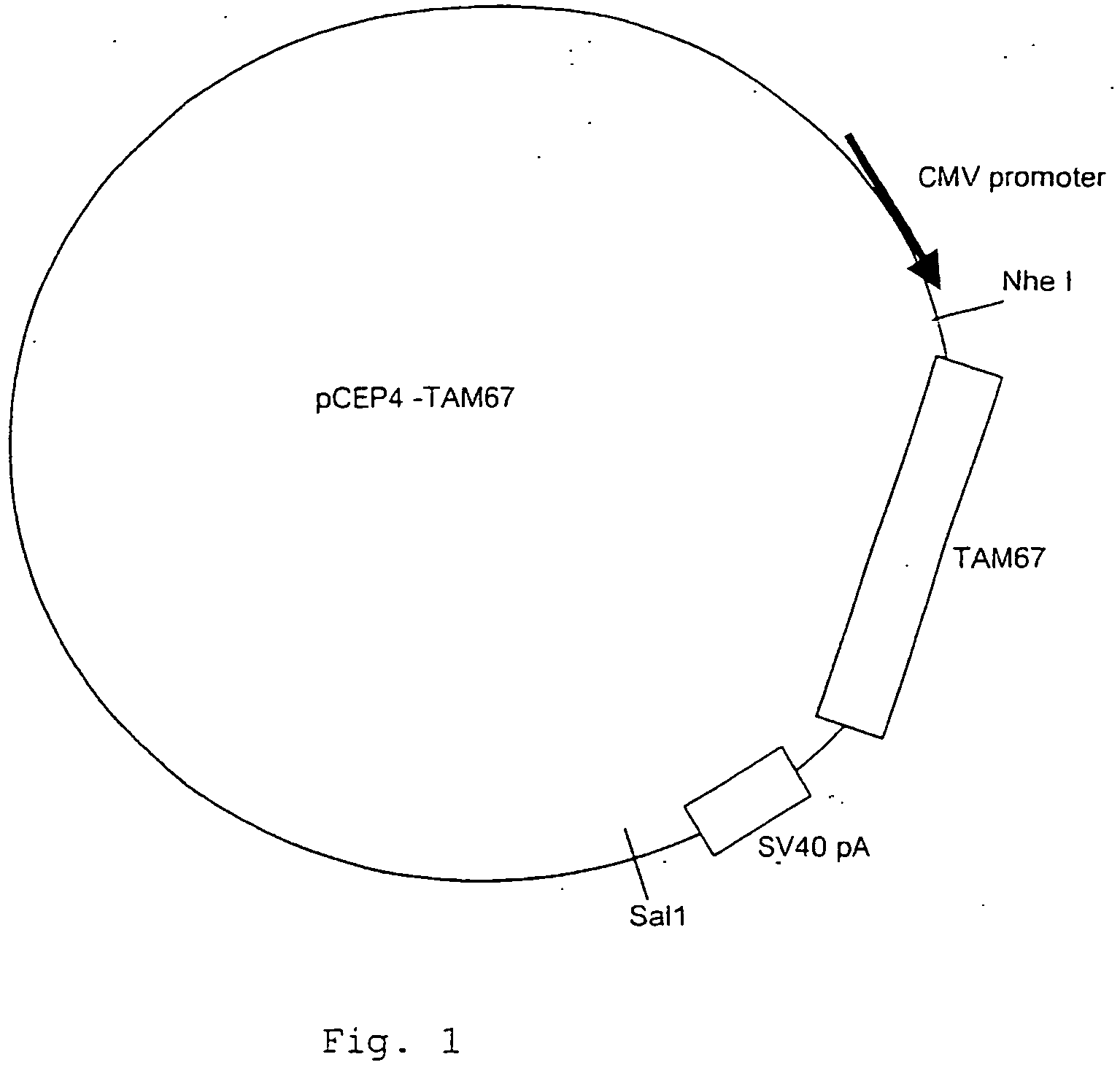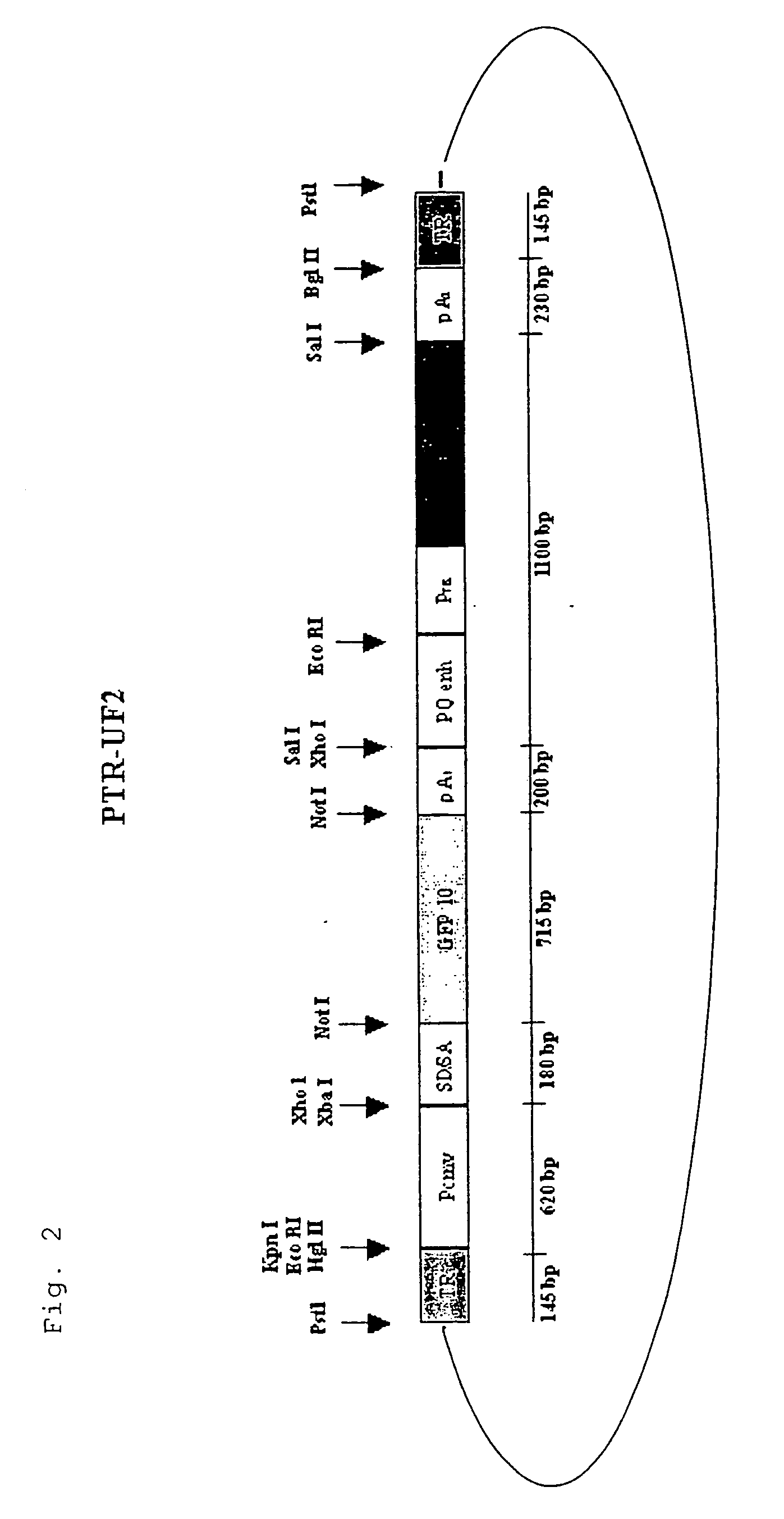Recombinant vectors derived from adeno-associated virus expressing tam67 for gene therapy
a technology of adeno-associated virus and gene therapy, which is applied in the direction of biocide, animal repellents, drug compositions, etc., can solve the problems of difficult treatment of many cancers, difficult treatment of tumors, and significant limitations of all treatment modalities
- Summary
- Abstract
- Description
- Claims
- Application Information
AI Technical Summary
Benefits of technology
Problems solved by technology
Method used
Image
Examples
example 1
Strategy to Obtain Recombinant AAV Particles (recAAV-TAM67)
[0037] Conventional methods for obtaining recombinant AAV (recAAV) particles are based on co-transfection of an eucaryotic cell line (mostly 293 cells) and upper-infection with adenovirus. One of the 2 co-transfected plasmids encodes the genome of the recAAV (bordered by a couple of inverted terminal repeats, the only remaining elements of the wtAAV genome), the other plasmid codes for the REP and CAP proteins of the wtAAV necessary for trans-complementation. The REP proteins are responsible for the synthesis of the recAAV genomes, while the CAP proteins are the structural molecules of the viral capsid. In order to realise the production of AAV particles cells have to be “activated”, e.g. by upper-infection with adenovirus, otherwise AAV remains under a latent form in the host cell. [0038] The plasmid coding for the REP and CAP proteins (pIM45; provided by N. Muzyczka) [0039] The plasmid encoding the recAAV genome (pTR-TAM...
example 2
Infection of Ovarian Cancer Cells with rAAV-TAM67.
[0043] Based on previous experiments with rAAV-GFP (results not shown), in which optimal conditions for transduction of ovarian cancer cells were explored, NIH-OVCAR3 cells were infected with rAAV-TAM67 (at a MOI of 5 infectious particles / cell) with or without addition of Ad5del308ΔpTP (Schaack J, Guo X, Langer S J. Characterization of a replication-incompetent adenovirus type 5 mutant deleted for the preterminal protein gene. Proc. Natl. Acad. Sci. USA 1996; 93: 14686-14691; Maxwell I H, Maxwell F, Schaack J. An adenovirus type 5 mutant with the preterminal protein gene deleted efficiently provides helper functions for the production of recombinant adeno-associated virus. J Virol 1998; 72: 8371-8372) at a MOI of 1 I.P / cell (in the experimental set-up adenovirus is added to obtain maximum expression levels of the recombinant gene). Controls included infection with Ad5del308ΔpTP alone, wtAAV infection (due to our production method t...
PUM
| Property | Measurement | Unit |
|---|---|---|
| pharmaceutical composition | aaaaa | aaaaa |
| attractive properties | aaaaa | aaaaa |
| size | aaaaa | aaaaa |
Abstract
Description
Claims
Application Information
 Login to View More
Login to View More - R&D
- Intellectual Property
- Life Sciences
- Materials
- Tech Scout
- Unparalleled Data Quality
- Higher Quality Content
- 60% Fewer Hallucinations
Browse by: Latest US Patents, China's latest patents, Technical Efficacy Thesaurus, Application Domain, Technology Topic, Popular Technical Reports.
© 2025 PatSnap. All rights reserved.Legal|Privacy policy|Modern Slavery Act Transparency Statement|Sitemap|About US| Contact US: help@patsnap.com



